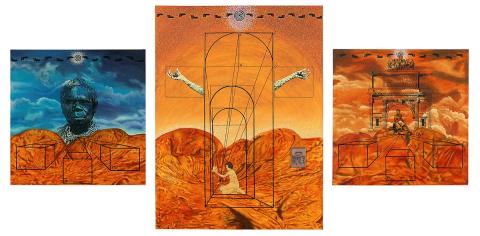Gordon Bennett: Triptych: Requiem, Of Grandeur, Empire
The panels of Gordon Bennett's Triptych: Requiem, Of Grandeur, Empire are superimposed with Renaissance visual schema often used in Western art. Each panel also features appropriated imagery to convey Bennett's political stance. The left panel, for example, is titled Requiem with a bitter irony - it depicts Truganini, historically described as 'the last Tasmanian Aborigine', and the figurehead for a supposedly dead race.
The central panel, Of Grandeur, deftly alludes to images of Christ on the cross by placing only the outstretched arms from Matthias Grunewald's The Crucifixion of Christ c.1505 on either side of a diagram of arches receding into a very low vanishing point. At the foot of this implied cross is a line drawing based on a 1940s news photograph of Bennett's missionary-student mother polishing an institutional staircase, with a framed copy of the original photograph to the right. The artist's mother is shown both in her original act of submission to the Church and in imitation of Mary Magdalene lamenting at the foot of Christ.
Empire, the right panel, is dominated by the Arch of Titus, a Judean-Roman arch erected during the period in which the Jewish diaspora began in the first century AD. This reference parallels the invasion and dispersion of Indigenous Australians with white settlement. The arch stands over a nineteenth-century postcard depiction of an Aboriginal seen as Jean-Jacques Rousseau's 'noble savage'.
The appropriated elements that Bennett brings together within the triptych are left deliberately unintegrated. In this way the structure and surface of the paintings themselves function as metaphors of segregation, or even more destructively, of insipid assimilation.
